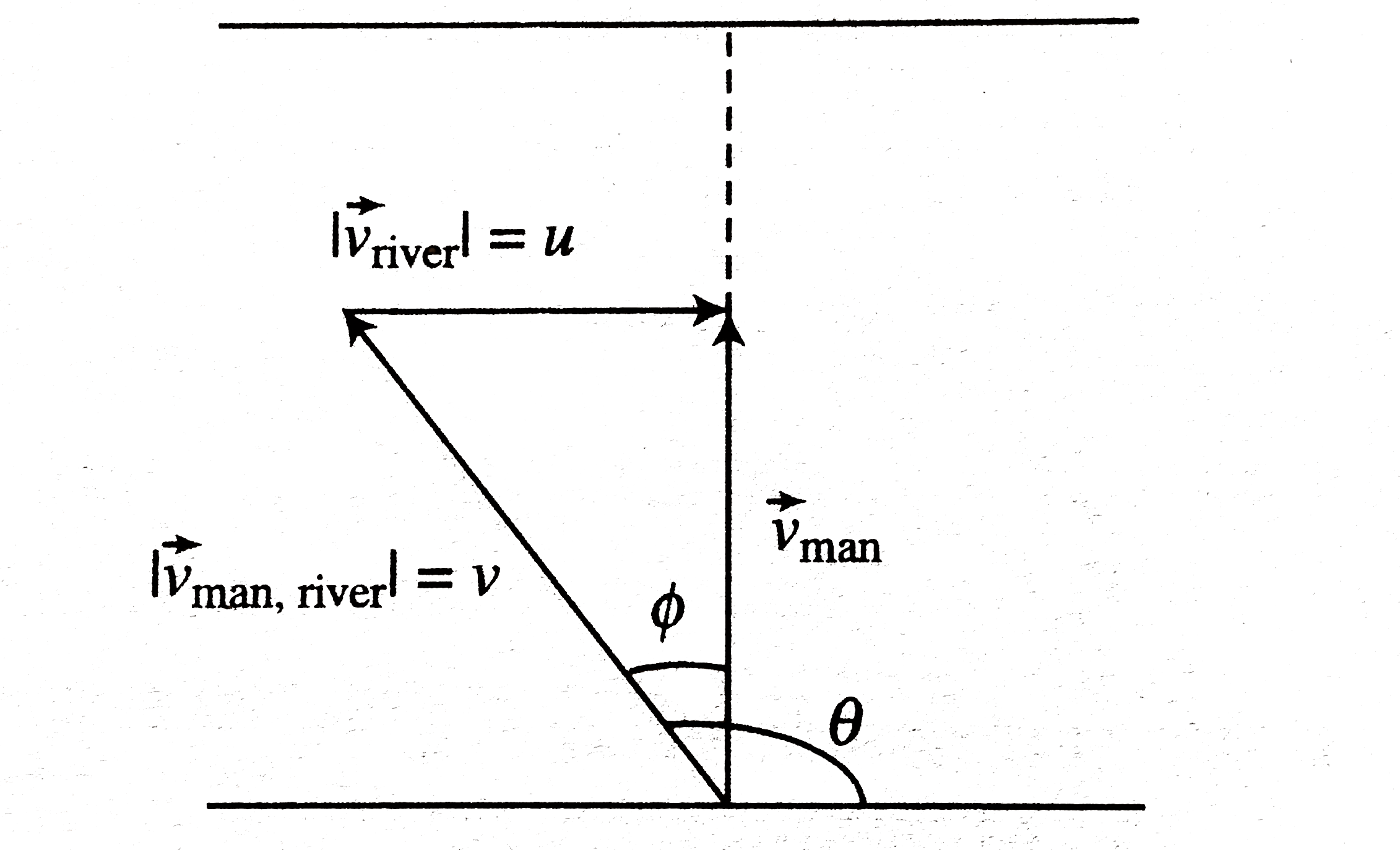A man can swim at the rate of 5kmh−1 in still water. A 1−km wide river flows at the rate of 3kmh−1 The man wishes to swim across the river directly opposite to the starting point.
(a) Along what direction must the man swim ?
(b) What should be his resultant velocity ?
( c) How much time will he take to cross the river ?
(a) Velocity of man with respect to river water, v=5kmh−1. This is greater than the river flow velocity. Therefore, he can cross the river directly (along the shortest path or no drift condition from flow velocity). The angle of swim,
θ=π2+sin−1(uv)
=90∘+sin−1(uv)
=90∘+sin−1(35)=90∘+37∘=127∘ w.r.t. the river flow
or 37∘ w.r.t. perpendicular in upstream direction.
 .
.
(b) Resultant velocity or velocity of mass will be
vm=√v2−u2=√52−32=4k=kmh−1
In the direction perpendicular to the river flow.
( c) time taken to cross the river
t=d√v2−u2=1km4kmh−1=14h=15min.
Topper's Solved these Questions
- BOOK - CENGAGE PHYSICSCHAPTER - KINEMATICS-2EXERCISE - Solved Examples7videos
KINEMATICS-2
- BOOK - CENGAGE PHYSICSCHAPTER - KINEMATICS-2EXERCISE - Exercise 5.115videos
KINEMATICS-2
- BOOK - CENGAGE PHYSICSCHAPTER - KINEMATICS-1EXERCISE - Integer9videos
KINEMATICS-1
- BOOK - CENGAGE PHYSICSCHAPTER - KINETIC THEORY OF GASESEXERCISE - Compression2videos
KINETIC THEORY OF GASES
Similar Questions
A man can swim at the rate of 5kmh−1 in still water A. One km wide river flows at the rate of 3kmh−1 . The man wishes to swim across the river directly opposite to the starting point. How much time will be take to cross the river
View SolutionA man can swim at the rate of 5kmh−1 in still water A. One km wide river flows at the rate of 3kmh−1 . The man wishes to swim across the river directly opposite to the starting point. How much time will be take to cross the river
View Solution
Knowledge Check
- Question 1 - Select One
A man can swim at the rate of 4 km/hr in still water . If the speed of the water is 2 km/hr , then the time taken by him to swim 10 km upstream is
A212 hrsB312 hrsC5 hrsD4 hrs - Question 2 - Select One
A man can swim with a speed of 4kmh−1 in still water. He crosses a river 1km wise that flows steadily at 3kmh−1. If he makes his strokes normal to the river current, how far down the river does he go when he reaches the other bank?
A500mB600mC750mD850m
A river 800m wide flows at the rate of 6kmh_1 in still water, wishes to cross the tiver straight. ltbRgt (a) Along what direction must he strike ?
(b) What should be his resultant velocity ?
(c ) How much time he would take ?View SolutionA river 800 m wide flows at the rate of 5kmh−1. A swimmer who can swim at 10kmh−1 in still water, wishes to cross the river straight. (i) Along what direction must be strike ? (ii) What should be his resultant velocity ? (iii) How much time he would take ?
View SolutionA river 600m wide wide flows at the rate of 8 km h^(-1). Still water, wishes to cross the river straight (i) Along what direction must be strike ? What will be his resultant velcity ? (ii) How much time he will take to cross the river ?
View SolutionA river 500m wide flows at a rate at a rate of 4kmh−1. A swimmer who can swim at 8kmh−1. In still water, wishes to cross the river straight. (i) Along what direction must he strike? (ii) What should be his resultant velocity. (iii) What is the time of crossing the river?
View SolutionA man can swim in still water with speed v. He wants to cross a river of width d that flows with speed u and reaches the point directely opposite to his starting point. (a) In which direction should he try to swim (i.e., find the angle the makes with the river flow)? (b) much time will he take to cross the river ?
View SolutionA man can swim in still water ast a speed of 3 km/h. He wants to cross a river that flows at 2 km/h and reach the point directly oposite to his starting point. A. In which diretionshoeld he try to swim (that is, find the angle his body makes wilth the river flow)? b. How much time will he take to cross the river if the river is 500 m wide?
View Solution

